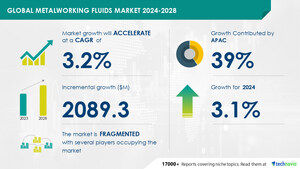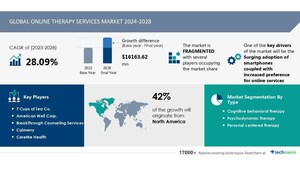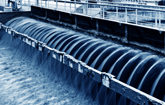NEW YORK, April 17, 2024 /PRNewswire/ -- The global HDPE pipe market size is estimated to grow by USD 6289.46 mn from 2023-2027, according to Technavio. The market is estimated to grow at a CAGR of 5.8% during the forecast period. The HDPE pipe market is experiencing growth due to escalating water demand, driven by population increase and industrial activities. Industrial and domestic sectors' water usage is projected to expand faster than agriculture. Construction, including luxury apartments and infrastructure improvements, fuels demand for pipes. HDPE pipes offer resistance to chemicals, abrasion, and temperature, making them suitable for various applications like water supply, oil and gas, and sewage systems. Manufacturing processes adhere to industry standards, ensuring eco-friendly practices and recycled materials. HDPE pipes' flexibility, reliability, and resistance to challenging environments make them a preferred choice for transportation networks.
For more insights on the historic (2017 - 2021) and forecast market size- Request a sample report
HDPE Pipe Market Scope |
|
Report Coverage |
Details |
Base year |
2022 |
Historic period |
2017 - 2021 |
Forecast period |
2023-2027 |
Growth momentum & CAGR |
Accelerate at a CAGR of 5.8% |
Market growth 2023-2027 |
USD 6289.46 million |
Market structure |
Fragmented |
YoY growth 2022-2023 (%) |
5.4 |
Regional analysis |
APAC, North America, Europe, Middle East and Africa, and South America |
Performing market contribution |
APAC at 49% |
Key countries |
US, China, India, Germany, and France |
Key companies profiled |
Advanced Drainage Systems Inc., APL Apollo TUBES Ltd., Astral Poly Technik Ltd., Atkore Inc., Genuit Group Plc, Georg Fischer Ltd., Hexatronic Group AB, JM Eagle Inc, Lane Enterprises Inc., LyondellBasell Industries Holdings B.V., Orbia Advance Corp. SAB de CV, POLYPLASTIC Group, Prinsco Inc., PTT Public Co. Ltd., Qenos Pty Ltd., Unidelta Spa, Uponor Corp., Wavin BV, Chevron Corp., and Formosa Plastics Corp. |
Segment Overview
This hdpe pipe market report extensively covers market segmentation by Application (Water supply, Agricultural irrigation, Sewage system, Oil and gas, Others) Type (PE 100, PE 80, PE 63) Geography (APAC, North America, Europe, Middle East and Africa, South America)
Market segmentation by Application
The High Density Polyethylene (HDPE) pipe market has experienced notable growth, particularly in the use of PE 100 pipes. Ideal for various industries, PE 100 pipes excel in water supply, agricultural irrigation, sewage systems, oil and gas, and more. In agriculture, modern farming practices rely on these pipes for efficient water distribution. In water supply, PE 100 pipes ensure reliability and resistance to chemicals, abrasion, and weathering. For sewage systems, their lightweight nature facilitates infrastructure improvement and construction projects. In the oil and gas sector, PE 100 pipes are used in refineries and processing plants for crude oil and refined products transportation. With eco-friendly practices and recycled materials like those from Jet Polymer Recycling, HDPE pipes contribute to reducing carbon footprint. Their flexibility and resistance to challenging environments make them suitable for installation in shifting soil conditions. PE 100 pipes are essential for gas distribution networks, ensuring temperature tolerance and reliability.
Geography Overview
The HDPE pipe market in APAC is experiencing significant growth, driven by the agricultural sector's increasing use of HDPE pipes for irrigation. In addition, the region's infrastructure development, including water supply and sewage systems, oil and gas industries, and construction of modern buildings, is boosting demand for HDPE pipes. The price increase in 2021 was due to rising upstream crude, naphtha, and ethylene values, limited product availability, and the manufacturing process's eco-friendly practices using recycled materials. HDPE pipes offer resistance to chemicals, abrasion, and temperature tolerance, making them ideal for various applications, including water supply, sewage systems, gas distribution networks, and plumbing systems. Their flexibility and reliability enable installation in challenging environments, such as shifting soil, and their lightweight nature reduces carbon footprint. Industry standards ensure the pipes' reliability and performance in diverse applications, from agriculture to petroleum distribution.
Insights on the market contribution of various segments including country and region wise, historic (2017 - 2021) and forecast market size- Download a Sample Report
- HDPE pipes are widely used in industries like mining, construction, agriculture, water supply, sewage systems, oil and gas, and gas distribution networks. Joining techniques like butt fusion and electrofusion apply heat for fusion, but these methods are time-consuming, costly, and require certified crews and fusion equipment. HDPE pipes offer benefits such as resistance to chemicals, abrasion, temperature tolerance, and flexibility. Manufacturing follows industry standards, and eco-friendly practices include recycled materials and jet polymer recycling. Applications include modern farming practices, infrastructure improvement, and luxury apartments. HDPE pipes are suitable for challenging environments and have high reliability.
- The HDPE pipe market caters to various industries, including construction, irrigation, and chemicals. HDPE pipes offer technical superiority over PVC pipes but are more expensive. In irrigation, HDPE pipes are crucial for optimal performance due to their durability, resistance to corrosion, and high strength. HDPE pipes are used in water supply systems, transportation networks, and mining activities due to their lightweight properties, flexibility, and ability to withstand high internal and external pressures. HDPE resin is the base material for manufacturing these pipes, which are suitable for transporting chemicals, fluids, and gases.
Insights on Market Drivers, trends, & Challenges, historic period(2017 - 2021) and forecast period(2023-2027)- Request a sample report!
Research Analysis
The High Density Polyethylene (HDPE) pipe market is experiencing significant growth due to the material's superior properties as a thermoplastic polymer. HDPE pipes offer excellent reliability and flexibility, making them ideal for various applications such as natural gas and petroleum distribution, water supply in farmlands, and automotive components like fuel tanks and bumpers. HDPE pipes exhibit remarkable resistance to chemical corrosion, abrasion, and weathering, ensuring long-term durability. Their resistance to shifting soil and ease of installation make them a preferred choice for transportation infrastructure. Moreover, HDPE pipes' lightweight nature contributes to vehicle weight reduction, enhancing fuel efficiency in automotive applications. However, emission regulations imposed by automakers necessitate the use of HDPE in place of metal pipes to minimize environmental impact. In addition, HDPE pipes are resilient to pesticides and other agricultural chemicals, making them suitable for use in water supply systems for crops. The versatility of HDPE pipes extends to industrial applications, including interior parts in vehicles and fuel tanks, further expanding their market potential.
Market Research Overview
The HDPE Pipe Market involves the production, sale, and implementation of High-Density Polyethylene pipes. These pipes are characterized by their durability, chemical resistance, and flexibility. The market consists of various players, including suppliers and distributors. The production process of HDPE pipes includes extrusion and blow molding techniques. HDPE pipes are widely used in various industries such as water and wastewater, oil and gas, and chemical processing. They are suitable for transporting corrosive and abrasive substances due to their resistance properties. The demand for HDPE pipes is increasing due to their cost-effectiveness and long service life. The market for HDPE pipes is driven by factors such as increasing infrastructure development, growing demand for water and wastewater treatment, and the need for efficient and reliable piping systems. The market is also influenced by regulatory frameworks and environmental concerns. The HDPE pipe market is competitive, with key players focusing on innovation, product development, and expansion. Some of the major players in the market include LyondellBasell, SABIC, and ExxonMobil Chemical. The market is expected to grow at a significant rate in the coming years due to the increasing demand for HDPE pipes in various end-use industries.
About Technavio
Technavio is a leading global technology research and advisory company. Their research and analysis focuses on emerging market trends and provides actionable insights to help businesses identify market opportunities and develop effective strategies to optimize their market positions.
With over 500 specialized analysts, Technavio's report library consists of more than 17,000 reports and counting, covering 800 technologies, spanning across 50 countries. Their client base consists of enterprises of all sizes, including more than 100 Fortune 500 companies. This growing client base relies on Technavio's comprehensive coverage, extensive research, and actionable market insights to identify opportunities in existing and potential markets and assess their competitive positions within changing market scenarios.
Contacts
Technavio Research
Jesse Maida
Media & Marketing Executive
US: +1 844 364 1100
UK: +44 203 893 3200
Email: [email protected]
Website: www.technavio.com/
SOURCE Technavio

WANT YOUR COMPANY'S NEWS FEATURED ON PRNEWSWIRE.COM?
Newsrooms &
Influencers
Digital Media
Outlets
Journalists
Opted In





Share this article